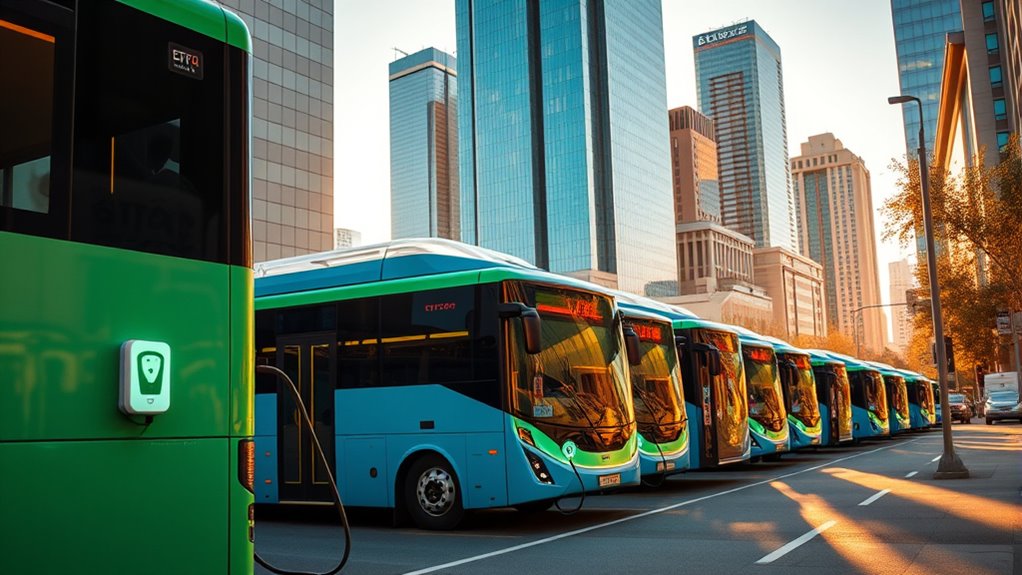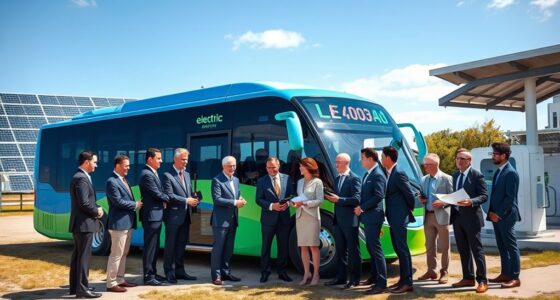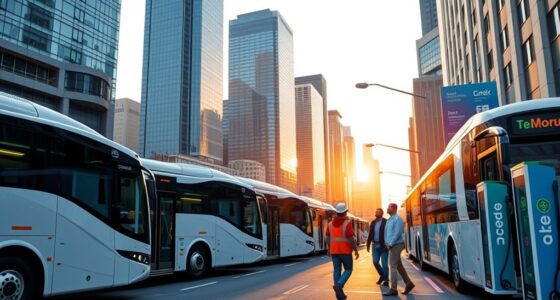Cities fund their electric bus fleets through a mix of federal grants, state and local partnerships, and innovative financing approaches. Federal programs like the FTA Low-No and the Clean School Bus Program provide substantial grants, while local collaborations and incentives encourage adoption. Many cities also use hybrid models, renewable energy solutions, and public-private partnerships to cover infrastructure costs and guarantee sustainability. Keep exploring to discover how these strategies transform urban transportation and energy use.
Key Takeaways
- Cities utilize federal grants like the FTA Low-No and Bus and Bus Facilities programs to fund electric bus purchases and infrastructure.
- Local and state partnerships combine resources through grants, incentives, and public-private collaborations for fleet and infrastructure development.
- Municipalities leverage climate bonds, green infrastructure funding, and renewable energy incentives to finance electric bus projects.
- Innovative financing models such as leasing, resource stacking, and selling carbon credits help reduce upfront costs and operational expenses.
- Cities benefit from dedicated programs, studies, and strategic planning to prioritize underserved communities and maximize funding efficiency.
Federal Grant Programs Supporting Electric Bus Adoption
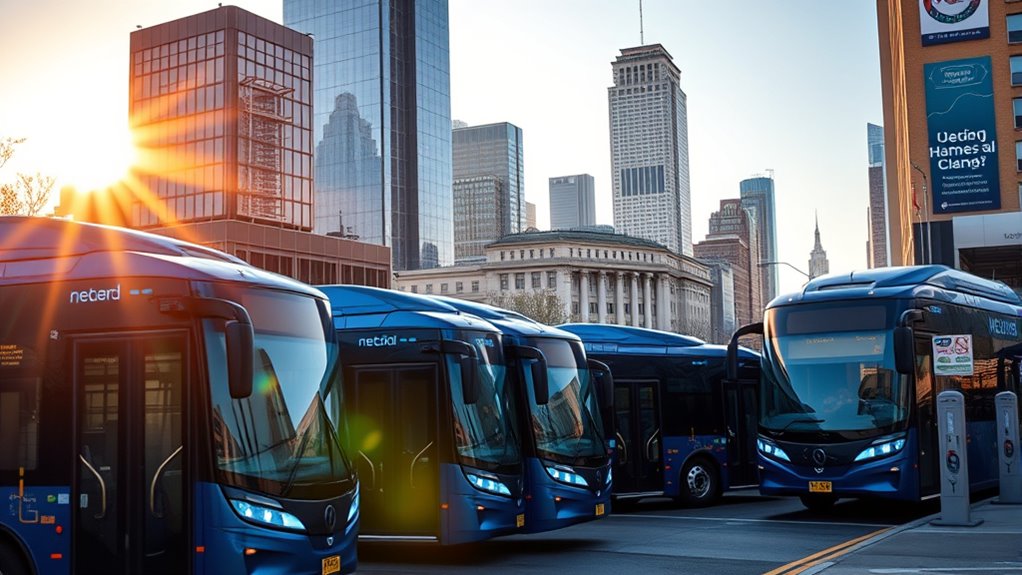
Federal grant programs play a crucial role in accelerating the adoption of electric buses across the United States. These programs provide competitive funding to states, transit agencies, tribes, and nonprofits operating fixed-route bus services.
Federal grants accelerate electric bus adoption nationwide, supporting transit agencies, tribes, and nonprofits in building sustainable transportation.
The Bus and Bus Facilities Program offers grants for replacing older buses, upgrading facilities, and adopting low/no-emission technologies. These initiatives often include funding mechanisms that help ensure the sustainability of electric fleet deployments over the long term. Incorporating sustainable funding methods can further enhance project viability and long-term success. Recognizing the importance of industry trends, stakeholders can better align their strategies with evolving market dynamics.
The Clean School Bus Program allocates $5 billion over five years to replace diesel school buses with zero-emission models.
Recent allocations, like the July 2024 award of $1.5 billion, support over 1,100 buses, mostly electric or hydrogen fuel cell.
These grants also fund infrastructure, workforce training, and R&D, emphasizing projects that benefit disadvantaged communities and meet emission reduction goals.
Additionally, integrating investment strategies and understanding market trends can help stakeholders optimize their funding and deployment plans.
The federal government’s focus on zero-emission fleets helps accelerate nationwide transition efforts.
State and Local Funding Collaborations
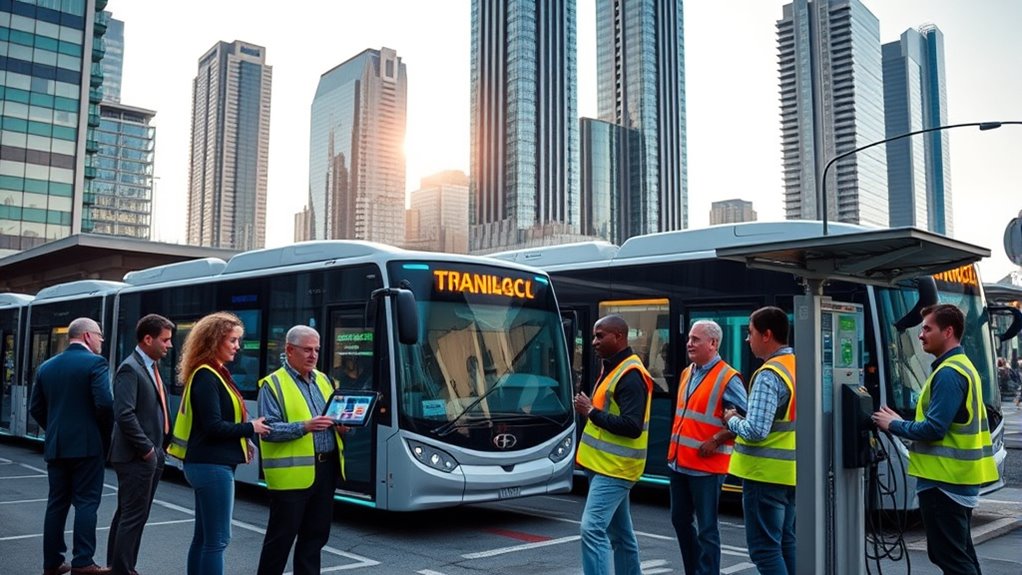
State and local governments often team up to fund electric bus fleets by combining resources and strategies. They frequently collaborate on grants, blending federal funds with local contributions to maximize impact. Nonprofit organizations like the Nevada Clean Energy Fund partner with local agencies to administer funds and offer technical support. Incorporating holistic approaches, such as mental health benefits, can also improve community well-being alongside environmental goals. These collaborations often leverage public-private partnerships to expand infrastructure investments and share risks. Many states provide incentives such as rebates or low-interest loans to encourage adoption. Cities also form public-private partnerships to finance infrastructure like charging stations. Funding is often allocated based on specific needs, ensuring densely populated or underserved areas receive attention. Application processes typically require detailed plans, and cost-sharing models help reduce expenses for cities. Additionally, funding often supports green infrastructure projects and workforce training, ensuring a smooth shift to electric fleets. Emphasizing community engagement can further enhance the success and acceptance of transition initiatives. Moreover, fostering collaborative planning among stakeholders can lead to more sustainable and efficient deployment of electric bus systems.
Leveraging Federal and State Partnerships for Large-Scale Projects

Leveraging partnerships between federal and state governments plays a crucial role in funding large-scale electric bus projects. You are trained on data up to October 2023. Incorporating project funding strategies ensures more comprehensive support for these initiatives. Additionally, understanding funding mechanisms allows stakeholders to optimize resource allocation and maximize project impact. Effective wall organization systems and eco-friendly materials can further support sustainable transportation infrastructure projects by promoting efficiency and environmental responsibility.
Incorporating Technology and Infrastructure Investments

Investing in advanced technology and infrastructure is essential for the successful deployment of electric bus fleets. You need to expand charging stations at key transit hubs and depots, utilizing high-power systems that often require grid upgrades.
Pilot programs testing wireless and overnight charging help optimize operations, while modular designs ensure scalability as your fleet grows. Partnering with utilities guarantees grid readiness for increased energy demands.
Smart fleet management systems, driven by AI, optimize routes, monitor battery health, and forecast energy needs, reducing costs and downtime. Battery technology advances, such as fast-charging and second-life programs, improve reliability and sustainability.
Data integration through IoT and analytics enhances operational efficiency, while public-private partnerships accelerate adoption of innovative solutions, ensuring your city’s electric bus system is both modern and resilient.
Addressing Environmental and Equity Goals Through Funding
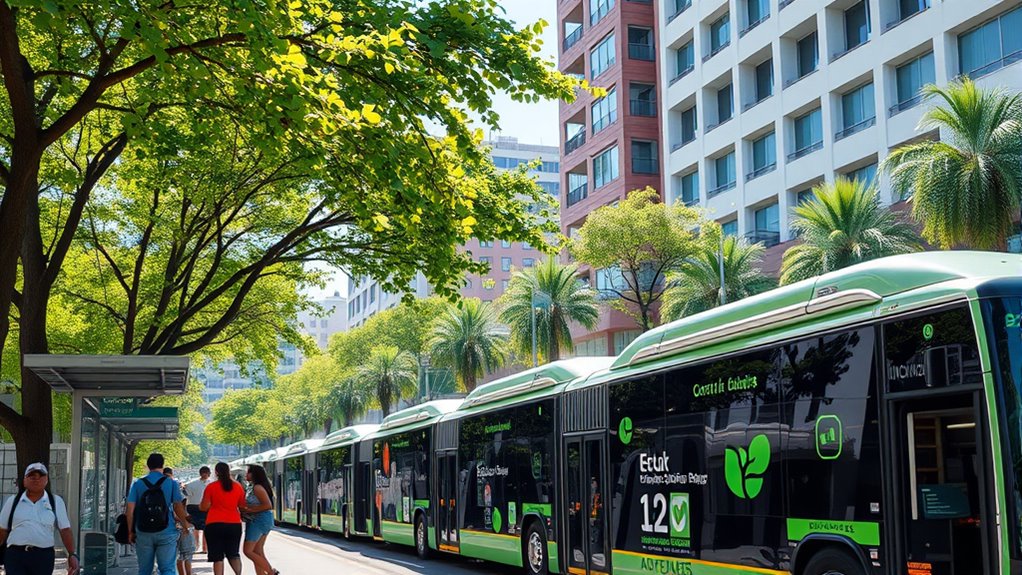
Funding plays a pivotal role in helping you meet environmental and equity goals as you shift to electric bus fleets. Federal grants like FTA Low-No support the purchase of electric buses and charging infrastructure, prioritizing underserved communities impacted by pollution. These grants often require matching funds and promote solar energy integration, as seen in Broward County’s renewable energy canopies. They also include workforce training to guarantee local job creation.
State and local funding alignments, such as public-private partnerships and climate bonds, leverage additional resources. Funding priorities target disadvantaged communities, aiming for emission reductions and improved public health. These financial incentives encourage cities to comply with regulatory deadlines, track emissions, and report on equity outcomes, ensuring that transition efforts benefit both the environment and vulnerable populations.
Developing Fleet Transition Timelines and Phasing Strategies
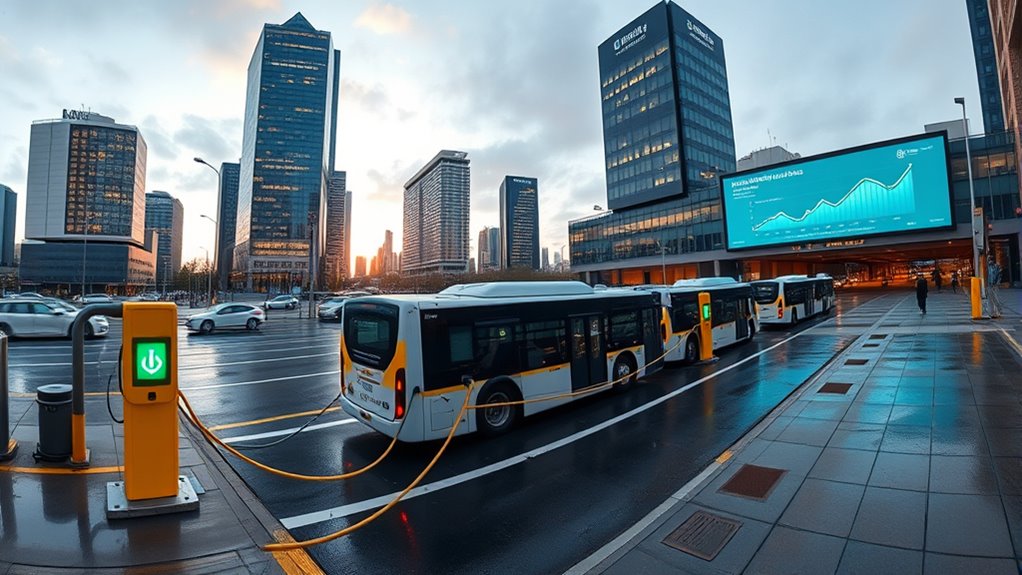
Establishing clear timelines and phased strategies is key to effectively replacing aging diesel and hybrid buses with electric models. Align your procurement schedules with fleet retirement cycles to guarantee replacements happen during natural turnover periods.
Start with early adoption pilots, like King County’s 40 extended-range BEBs in 2022, to test performance before larger deployments. Coordinate vehicle orders with charger installation timelines to prevent infrastructure delays.
Consider transitional hybrid-electric purchases if facility constraints exist, as SFMTA plans for 2025 procurements. Develop multi-year procurement plans, such as from 2024 to 2035, to systematically phase out older buses.
Incorporate infrastructure synchronization by constructing test charging facilities and upgrading power supply partnerships early. This structured approach guarantees smooth fleet transitions, minimizes service disruptions, and maximizes funding efficiency. Additionally, studying historical seed use can provide insights into sustainable material sourcing and long-term planning. Implementing payment solutions that support project funding and vendor payments can streamline financial management during these transitions. Recognizing the importance of butter making in sustainable practices can inspire innovative approaches to using renewable resources in vehicle manufacturing and infrastructure development. Moreover, paying close attention to Gold IRA regulations can serve as a valuable analogy for understanding compliance and risk management in large-scale public projects.
Innovative Financing and Resource Stacking Techniques
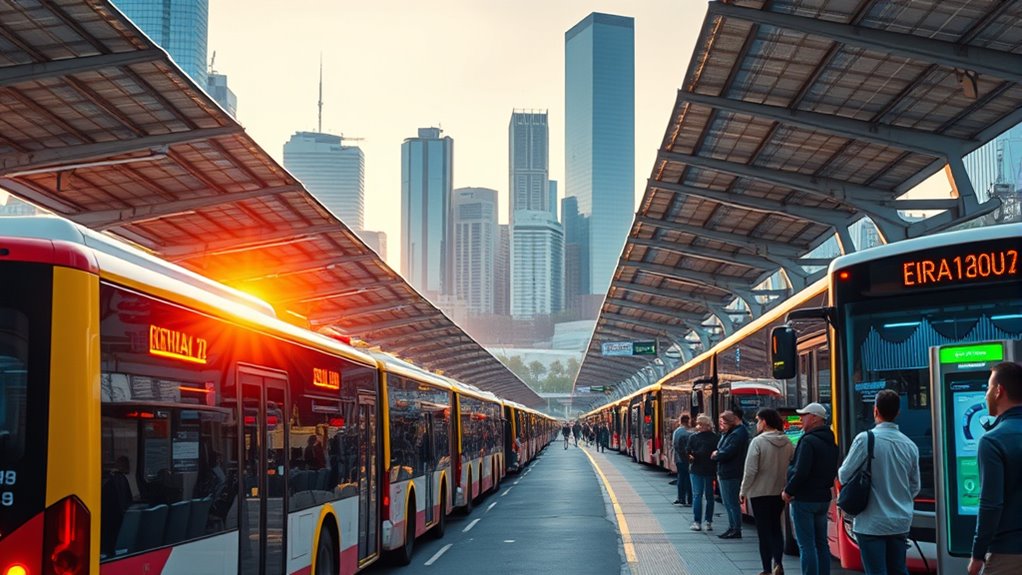
Innovative financing and resource stacking techniques enable transit agencies to expand electric bus fleets more effectively by leveraging multiple funding sources and financial strategies. You can combine grants and loans to cover different costs, like bus procurement and infrastructure upgrades.
Public-private partnerships help share expenses and access private sector expertise, reducing financial pressure. Utilizing energy efficiency incentives and tax credits lowers long-term operational costs and upfront expenses.
Selling carbon credits from reduced emissions creates additional revenue streams, supporting fleet expansion. Battery leasing models, such as Proterra’s, convert high upfront costs into manageable operating expenses. Additionally, implementing energy storage solutions can enhance grid stability and maximize renewable energy use, further improving cost efficiencies. Energy storage systems can also provide backup power during outages, increasing fleet resilience.
These approaches allow you to minimize capital expenditure, accelerate fleet deployment, and maximize available resources—all while improving environmental outcomes. By stacking resources creatively, you can overcome funding challenges and achieve a sustainable, cost-effective transition to electric buses. Greek Sceptic offers insights into alternative investment strategies that can further enhance funding options for such projects.
The Role of Hybrid and Renewable Energy Solutions
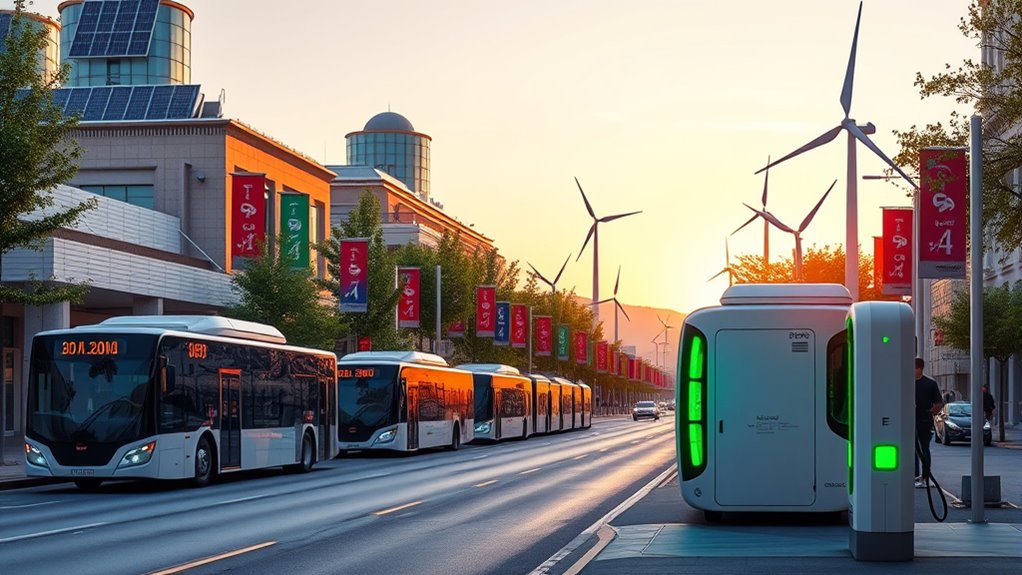
Hybrid and renewable energy solutions play an essential role in advancing electric bus fleets by enhancing efficiency and reducing emissions. Hybrid buses combine an internal combustion engine with an electric motor, consuming less fuel and cutting emissions by up to 75%. They offer operational flexibility, switching between electric and engine modes without requiring extensive charging infrastructure, making them easier to deploy. Many hybrid buses can use renewable fuels like biogas, biofuels, or solar energy, further lowering environmental impact. Energy recovery systems capture kinetic energy, boosting efficiency. These buses improve urban air quality through lower pollutants, quieter operation, and increased fuel savings. Additionally, advances in quantum computing are expected to optimize route planning and energy management for smarter bus fleet operations. Scalability and smart technologies, such as geofencing and connectivity, enable cities to optimize performance and integrate hybrid solutions into existing systems effectively. Incorporating energy optimization strategies ensures that these solutions remain sustainable and cost-effective as cities expand their transit networks. Furthermore, ongoing research into battery technology continues to improve storage capacity and charging times, making electric options increasingly viable. Moreover, integrating renewable energy sources into charging infrastructure can further enhance the sustainability of electric bus fleets, aligning with broader environmental goals.
Case Studies of City-Specific Funding Approaches
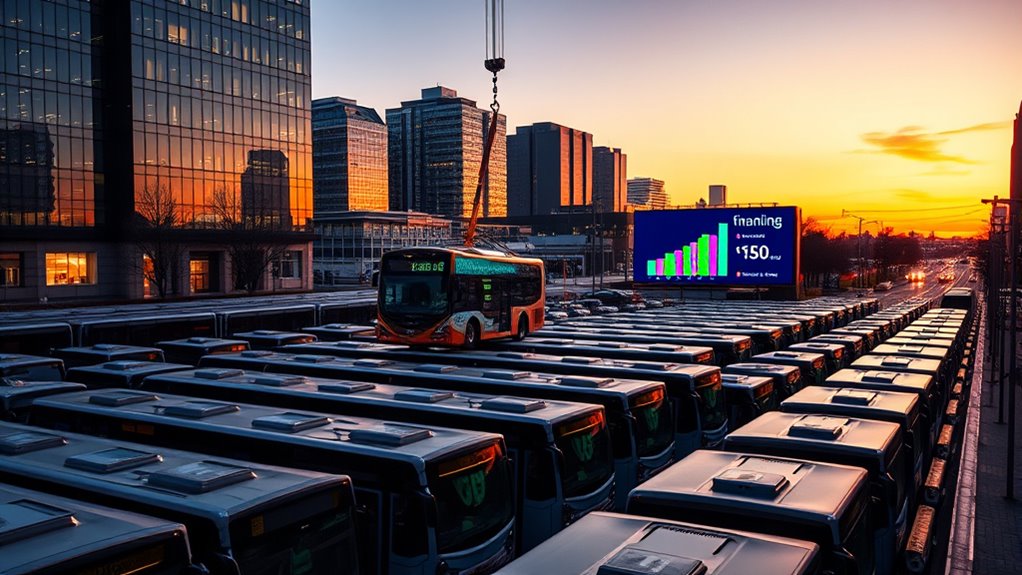
Cities adopt diverse funding strategies to support electric bus fleets, tailoring approaches to their unique needs and resources. For example, New York City has benefited from federal grants and studies that highlight costs and benefits, helping justify investments. The Federal Transit Administration (FTA) and programs like the IIJA funding support bus replacements and infrastructure upgrades. Utilizing market research also helps cities identify high-growth sectors and optimize their investment approaches to support sustainable transportation initiatives.
Rural areas access programs like the Low or No Emission Bus Discretionary Program to transition fleets. Municipalities, such as Winter Park, Florida, prioritize long-term savings through leasing options and budget planning. Public-private partnerships also play a key role, involving energy firms and tech companies to finance infrastructure and leverage incentives.
These strategies demonstrate how cities combine grants, partnerships, and budgets to effectively fund their electric bus initiatives.
Frequently Asked Questions
How Do Cities Prioritize Projects for Federal Funding Allocation?
You prioritize projects for federal funding by evaluating community needs, economic benefits, and environmental impacts. You consider eligibility criteria, deadlines, and matching requirements to guarantee alignment.
Cost-benefit analyses, public feedback, and performance metrics help determine which projects provide the highest value. Collaboration with stakeholders and transparency in decision-making ensure that funds go toward initiatives that promote safety, sustainability, and community well-being effectively.
What Are Common Challenges in Securing Matching Funds From States?
You’ll find that securing matching funds from states can be tough due to several challenges. Higher upfront costs of electric buses make it harder to justify funding, while limited state budgets force tough prioritization.
Complex application processes, bureaucratic delays, and inconsistent policies also slow things down. Building strong community support, partnering with private entities, and developing grant writing skills can improve your chances of successfully securing these essential funds.
How Do Cities Measure the Success of Their Funded Electric Bus Programs?
Like Da Vinci’s masterful strokes, you measure your electric bus program’s success through detailed performance metrics. You track energy usage, reliability, and operational uptime to gauge efficiency.
Emissions reductions and air quality improvements serve as environmental benchmarks.
Financially, you analyze total cost of ownership and operational savings.
These indicators combined help you assess whether your investments foster sustainable, efficient transit, ensuring your fleet’s true impact mirrors your ambitious vision.
Are Private Companies Involved in Financing or Supporting Electric Bus Projects?
You’ll find that private companies play a significant role in funding and supporting electric bus projects. They provide loans, investments, and financing solutions, like specialized debt instruments, to help cities expand their fleets without big upfront costs.
Private banks and investors also back these initiatives, often pairing grants with financing to reduce risks. Their involvement makes it easier for cities to adopt electric buses quickly and sustainably.
What Strategies Do Cities Use to Ensure Equitable Service Across Communities?
Did you know that cities with equitable transit planning see a 25% reduction in pollution disparities?
You can guarantee fair service by engaging local communities early, prioritizing underserved neighborhoods, and strategically placing charging stations.
Collaborate with utilities and stakeholders to develop inclusive infrastructure.
Focus on route optimization, reliable service, and ongoing outreach.
These strategies make sure electric bus benefits reach everyone equally, promoting cleaner air and better mobility for all residents.
Conclusion
You now see how cities are creatively funding electric bus fleets through federal grants, state partnerships, and innovative financing. An impressive 80% of city transit agencies report that these combined efforts have accelerated their shift to cleaner transportation. By leveraging technology and energy solutions, you’re part of a movement that’s not just reducing emissions but also creating equitable, sustainable transit. Together, these strategies guarantee a greener future for your city and generations to come.
